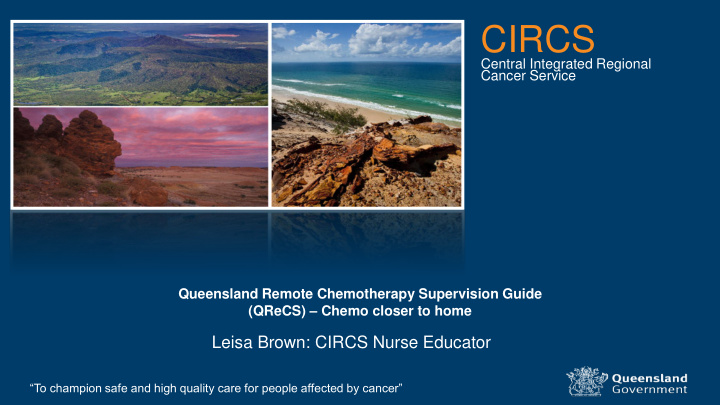



CIRCS Central Integrated Regional Cancer Service Queensland Remote Chemotherapy Supervision Guide (QReCS) – Chemo closer to home Leisa Brown: CIRCS Nurse Educator “To champion safe and high quality care for people affected by cancer” CIRCS Central Integrated Regional Cancer Service
Queensland Department of Health • Recognises the need to explore innovative ways to bring sustainable and equitable care to Queenslanders CIRCS Central Integrated Regional Cancer Service
QLD Telehealth Infrastructure • Largest managed Telehealth Network in Australia • Over 2000 systems (hardware and software) • More than 200 facilities (Andrew Bryett – Director Telehealth Services: Dept. of Health – QLD: 2015) CIRCS Central Integrated Regional Cancer Service
Aim …to support the safe and sustainable administration of chemotherapy closer to home for patients from rural and remote areas using Telehealth technologies
10 Requirements 1. Strategy and governance 2. Financial considerations 3. Workforce 4. Chemotherapy medication management 5. Telehealth readiness 6. Chemotherapy administration readiness 7. Information technology and support 8. Legislation and special consideration 9. Education and training 10.Documentation and discharge CIRCS Central Integrated Regional Cancer Service
Provider and Recipient QReCS adopts the hierarchy of health services in accordance with the Clinical Services Capability Framework CIRCS Central Integrated Regional Cancer Service
Workforce CIRCS Central Integrated Regional Cancer Service
Technology • Real time videoconferencing technology is essential • Standard videoconferencing equipment will generally be adequate to support chemotherapy administration • For assessing reactions, video or web cameras used at recipient site need to have the capacity for close ups whilst retaining good resolution • Essential that the technology and communication systems have the capacity to support live audio and video interactive links CIRCS Central Integrated Regional Cancer Service
Training Delivery Combination of delivery models are used to maintain an inclusive and interactive learning experience with technology playing a key role: • E-learning • Interactive workshops via videoconferencing • Simulated skill demonstrations and practice via videoconferencing and face-to-face • Competency assessments via videoconferencing and face-to- face CIRCS Central Integrated Regional Cancer Service
CIRCS Central Integrated Regional Cancer Service
Cancer Service Implementation • Nurses in rural and remote communities administer chemotherapy upon completion of relevant education and a minimum of 3 days supervised clinical practice placement at provider site – CIRCS Cancer Education Program supports staff to acquire theoretical knowledge and clinical skills to meet QReCS requirements – >1300 participants in program during 2014 CIRCS Central Integrated Regional Cancer Service
QReCS CIRCS Central Integrated Regional Cancer Service
Cancer Care Closer to Home • Telehealth technologies have been integral to: – Expanding the knowledge and skills of the staff providing care in rural and remote locations – Saving patient travel expenditure and enhancing quality of life by bringing care closer to home https://www.health.qld.gov.au/circs/html/qrecs.asp CIRCS Central Integrated Regional Cancer Service
Acknowledgments • Dr Sabe Sabesan – Townsville Cancer Centre and Tropical Centre for Telehealth Practice and Research, The Townsville Hospital • Maree Bransdon – CIRCS • Geoffrey Bryant – CIRCS The patients and health care staff in rural and remote communities that have supported the implementation of the QReCS model CIRCS Central Integrated Regional Cancer Service
Recommend
More recommend